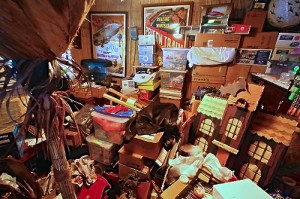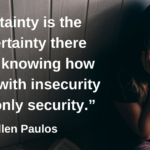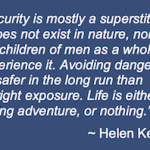Follow @ocdla
Hoarding affects the entire family. Here is one woman’s story of her struggle as the daughter of multiple generations of hoarders. She has asked to remain anonymous.

(cc image courtesy of puuikibeach)
I am the daughter of a hoarder. I am also the granddaughter of a hoarder. Somewhere amidst the cluttered chaos, I was a child. Competing with nine cats, three large dogs and compulsive shopping sprees was nothing but ordinary. Our 1500 square foot condo was stuffed wall-to-wall with dusty antique furniture, balls of cat fur, and the potent smell of animal urine masked by dozens of cheap burning candles. Taking in animals and acquiring things were my mother’s attempt to fill the absence of her husband and distract her from her long battle with cancer. She barricaded herself from the real world, consequently shutting down the needs of her only child and leaving no room for a relationship.
An unlikely suspect, my mother is an entrepreneur who dresses sharp, presents with confidence, and is admired and respected by her peers. What many people don’t know about the world of hoarding is that it is often a secret to outsiders. Although some hoarders can be detected by the clutter surrounding their homes, others present the exterior of their homes as well as they present themselves. From the outside world, we went unnoticed, further silencing my cry for help.
Owning her own business, my mother spent many long days at work, leaving me alone among the clutter of animals and collections. When she did come home, she would immediately go to her room and tend to her animals. Desperate for her attention, I often crawled across the thick coat of animal fur covering her bed to spend time with her looking through piles of fashion magazines. I would help her pick out thousands of dollars of clothing she never wore or returned. The focus of her hoarding and collecting constantly changed: bath salt scrubs one month, and variations of socks the next, always changing.
To the ordinary person, this life seems bizarre and disturbing, but to a child who knew nothing else, it seemed ordinary. I lived part time with my grandparents, who also shared the common denominator of hoarding. Their items were of a different nature than my mom’s: doll filled rooms, hundreds of woodcarvings, and unworn, color-coordinated clothes neatly organized in every closet. My grandparents’ house was clean and organized, but their lives were filled with the same distorted beliefs as my mom. These were “collections,” they would tell me. My grandmother convinced me that the collections were of extreme value and would be passed down to me after she died. My mother convinced me that her cats were in need of a home and that her shopping was a release from her stressful business. Believing these fictions allowed me to accept their condition. However, normalizing this behavior caused me more pain as I grew older when I came to realize that the mess surrounding me was not the standard.
I was in middle school when my mother’s compulsive behavior was brought to my attention. Not thinking much about my cluttered home, I brought a friend home to study and hang out, as most 13 year-old kids do. When we entered my house, I immediately noticed her disgusted facial expression. She quickly told me she had to call her mother because she wasn’t feeling well. I was mortified the next day when I heard her telling all our friends that my house was disgusting and smelled like cat pee. I felt a mixture of shame, embarrassment, and defensiveness. But as mad as I was at my mother, I was more upset that someone else was making fun of her.
Being a child of a hoarder was confusing and painful and always will be. For the rest of my teenage years, I never brought a single friend over again. One of the repercussions of my mother’s hoarding and cluttering was the disintegration of our relationship. Tempers would flare when I would turn down her requests to store things in my room. Accusations of throwing away something “important” became a common theme when I would attempt to clean the clutter. I felt suffocated, bitter, and disgusted.
When I left for college, I was determined to be the exact opposite of my family. To this day I keep nothing in my car and my home is perfectly clean and organized. I always think through every purchase and strategically map out where an item will go. My white, perfectly organized, and mostly under–decorated home, is a direct response to my once chaotic life as a child. My fear of adopting my family’s hoarding tendencies has subsequently made me a perfectionist.
After the death of my grandfather, the hoarding and collecting intensified for my grandmother. Five years after his passing, my grandmother’s house now has two rooms entirely filled, wall-to-wall, floor to ceiling, each with a specific type of doll. Every table, counter, corner, bedroom, and bathroom has a doll. Many rooms and halls have built-in cabinets of dolls behind glass cases. Each one has a very specific story and sentimental value that is priceless to her. Each closet has on average six of the same style clothing items, all in different colors, all with price tags still attached. The bathroom drawers are filled with hotel shampoos, conditioners, and soaps. My grandmother’s compulsive shopping has also spiraled out of control, resulting in debt that has forced her to sell the last three remaining properties my grandfather left to our family.
The lifestyle of a hoarder is painful and torturous for loved ones. As a child I felt isolated, angry, and helpless. As an adult, I now see that my mother and grandmother feel just as isolated and helpless as I once felt. The hoarding has always been a way to distract them from and mask their pain. There are many secrets that hoarding families keep from the outside world, making it hard to recognize, and further isolating them and their families. When hoarders normalize their actions, it reinforces the delusion that nothing is wrong with their behavior. Loved ones of hoarders fear judgment by outsiders, yet at the same time fear hurting the hoarders they love, which only makes it harder to ask for help.
The good news is that the pain and suffering can be effectively treated. Despite the many years of silence, my mother made the first step to change by seeking help. She sought treatment and has since cleared the clutter with the help of a cognitive behavioral therapist and the support of her future therapist daughter. Recognizing that the hoarding is a problem is the first and often the hardest part of recovery. But with the right treatment and support, hoarders and their families can move beyond the denial to a less chaotic life.
•The OCD Center of Los Angeles is a private, outpatient clinic specializing in Cognitive-Behavioral Therapy (CBT) for the treatment of Obsessive-Compulsive Disorder (OCD) and related conditions, including Hoarding. In addition to individual therapy, the center offers six weekly therapy groups, as well as online therapy, telephone therapy, and intensive outpatient treatment. To contact the OCD Center of Los Angeles, click here.




























































12 Comments
wow,i can totally understand completely both sides of what she has written.i myself come from a home well notcompletly hoarders but very cluttered .i my self felt those same feelings growing up and went to the same direction of over compensating with cleanliness,but now due to deaths and some other issues i have found my house starting to get well… “full” lol.not funny but it crept up and one day i was like wow im back to when i was 10 or so.i have been trying to unmess the mess – have started but its a long road .so anyway i feel her pain and glad that some one was their to help her mother and that she has found footing for herself and mother .
Hi Sal – I am glad my story was able to validate many of the emotions you experienced as a child and now as an adult
Thank you so much to this daughter and granddaughter of hoarders for sharing her powerful story.
Hi Donna – Thanks for your kind words. I was happy to share my story for others who relate to the world of hoarders. My intention was to validate those who didn’t have a voice.
Thank you for sharing your story. My heart breaks for the little girl who had to deal with far more than she should have had to. It is amazing to read how you have triumphed and are now going on to make a difference in the lives of others. Just getting the word out that hoarding is treatable will surely help many.
Hi Janet – The road to treatment is not an easy one. However, effective treatment exists. Cognitive Behavioral Therapy changed my mother’s life and mended much of our relationship.
As I read the article, I wondered how you achieved getting your mother to see the problem as a problem, rather than a collection of valuable things, and to be receptive to the cognitive behavioral therapist. That is such a difficult step to face and It would be helpful to know how that step was taken. We all know what it is like to create the hoard and what it is like to live with it. But the rub is in finding the way to take that first step that is so terrifying to deal with – the emotionally flawed connection to the stuff. I would like to hear more about that if possible.
Hi Paula -The most difficult step towards treatment is recognizing that the hoarding is a problem. My mother truly believed her compulsive shopping and collecting was justified and needed.
My mom read your comment and told me there was one moment she will never forget. She remembers the day I told her I would never go to her house again until she cleaned it up. It took close to 24 years to say those words. The pain I saw in her face was devastating. She explained to me this moment opened her eyes to what she could lose.
I knew we had to conquer this together. My approach was compassion to a woman who felt real pain and above all, she was my mother. This was a tedious journey for the both of us. There were many weeks she resented me and reverted to her old ways. She accepted failures, and she also accepted my help most days.
My mom will work the rest of her life to manage her hoarding. I have faith she will continue to succeed and forgive herself when there are days she does not. There is no magic pill, only work.
Thank you for sharing this thoughtful reply to Paula, Anonymous. That question your mom addressed …what it was that she really wants most… needs to be the driving force for changing attitudes and attachments . You two are fortunate that this was a moment that resonated so, and the work that you’ve accomplished together since then gives me hope.
Hi Josie- I am happy my mother’s response resonated with you and gave you hope.
I suffer from anxiety, panic disorder, and OCD and have since I can remember. My husband of twenty years has already left. I know these thoughts are irrational but they are controlling. I can’t get away from something that is inside of me.
I can relate to this post very much so. Im 21 and only recently realized hoarding and clutter were legitimate problems. I had been raised to view this as normal but am now beginning to understand that I was right all along…animal feces, the gross urine smell, dirty dishes piling up, and a general neglect of one’s living quarters is not the way life is meant to be lived. My mother displays some of these tendencies and my grandmother is as you described…very clean house, but has 30 years worth of clothes neatly packed away, tons of cookware that she MIGHT have time to use one every couple months, etc. I think that I was beginning to take the same route but am now planning to make sure this does not happen. Thank you for this inspiring post.